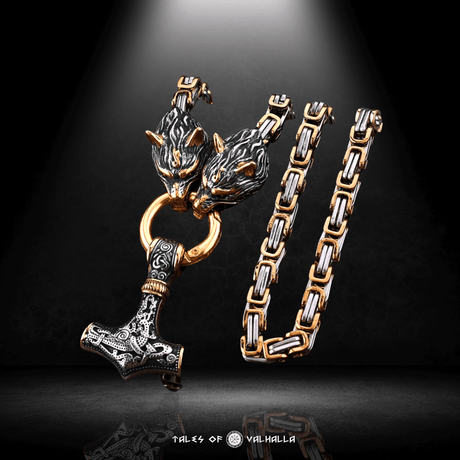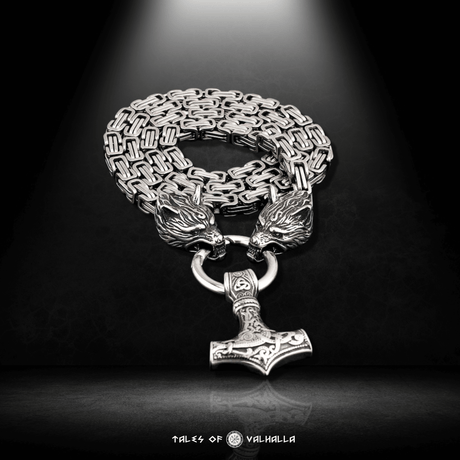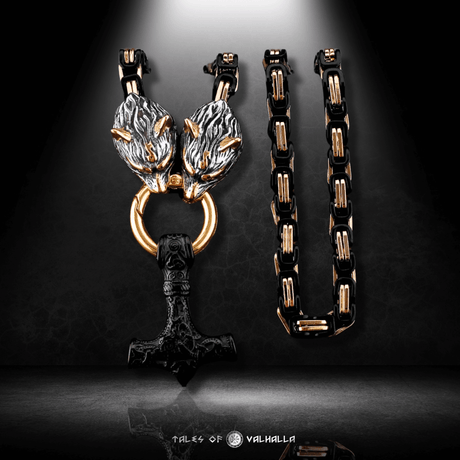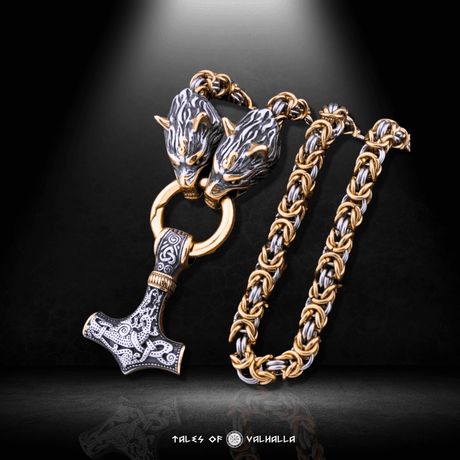Loki, the trickster god of Norse mythology, is one of the most enigmatic and complex figures in the pantheon. Known for his shape-shifting abilities and mischievous nature, Loki's actions often lead to chaos and disruption. However, his legacy extends beyond his own deeds—Loki is also the father of several powerful and fearsome beings who play pivotal roles in the Norse cosmos. Among these are Hel, the ruler of the underworld; Jörmungandr, the World Serpent; and Fenrir, the monstrous wolf destined to kill Odin during Ragnarok.
In this blog, we'll explore the stories of Loki's children, their origins, and their impact on Norse mythology. We’ll delve into their symbolic meanings and how they contribute to the rich tapestry of Norse mythos.
The Offspring of Loki and Angrboða
Hel - The Daughter of Loki and Queen of the Underworld

Hel - The Daughter of Loki and Queen of the Underworld
Hel’s Origins and Domain
Hel, one of the most intriguing figures in Norse mythology, is the daughter of Loki and the giantess Angrboða. Unlike her brothers, Jörmungandr and Fenrir, Hel’s domain is not in the physical world but in the afterlife. She rules over Helheim, the realm of the dead, where she governs those who did not die in battle. Hel is depicted as a grim and somber figure, half alive and half dead, with one side of her body appearing as a beautiful woman and the other side as a decaying corpse.
Helheim, her domain, is a cold, dark place far removed from the more glorious afterlife of Valhalla, where warriors slain in battle reside. It is here that the souls of those who died of old age, illness, or other non-heroic deaths are sent. Despite its grim reputation, Helheim is not necessarily a place of punishment; rather, it is simply the final resting place for many.
The Symbolism of Hel in Norse Mythology
Hel represents the inevitability of death and the natural order of life. Her dual appearance—half living and half dead—symbolizes the fine line between life and death, and the inevitability that all living beings must eventually cross that boundary. In this sense, Hel is a figure of both fear and acceptance, embodying the Norse understanding of death as a natural part of existence.
Hel’s role as the ruler of the underworld also underscores the Norse belief in the cyclical nature of life and death. Unlike the Christian concept of Hell as a place of eternal torment, Helheim is more of a neutral, albeit grim, resting place. Hel herself is not a malevolent figure but rather a caretaker of the dead, a role that reflects the Norse acceptance of mortality.
Jörmungandr - The Midgard Serpent

Jörmungandr - The Midgard Serpent
The Birth of the World Serpent
Jörmungandr, also known as the Midgard Serpent, is another child of Loki and Angrboða. According to Norse mythology, Jörmungandr was so large at birth that Odin, the Allfather, cast him into the ocean that encircles Midgard (the world of humans). There, Jörmungandr grew to such an enormous size that he could encircle the entire world and bite his own tail, a symbol often associated with the ouroboros.
Jörmungandr’s existence is deeply tied to the fate of the world. As the Midgard Serpent, he represents the concept of the world being encircled and bound by fate. His presence in the ocean signifies the vast and uncontrollable forces of nature that surround and influence human life.
Jörmungandr and the Prophecy of Ragnarok
Jörmungandr is fated to play a crucial role in Ragnarok, the end of the world in Norse mythology. According to the prophecy, when Ragnarok begins, Jörmungandr will release his tail, causing massive tidal waves and flooding. He will then rise from the ocean to engage in a deadly battle with Thor, the god of thunder.
The confrontation between Jörmungandr and Thor is one of the most anticipated events in Norse mythology. It is said that Thor will ultimately slay the serpent, but not before Jörmungandr poisons him with his venom, leading to Thor’s death shortly afterward. This battle between the god and the serpent symbolizes the clash between order and chaos, with both forces ultimately destroying each other.
Jörmungandr’s role in Ragnarok highlights the inevitability of fate and the cyclical nature of time in Norse mythology. His existence and eventual death are part of the larger cosmic order, where destruction and renewal are inextricably linked.
Fenrir - The Monstrous Wolf

Fenrir - The Monstrous Wolf
The Growth of Fenrir and the Gods' Fear
Fenrir, the third and most fearsome child of Loki and Angrboða, is a gigantic wolf whose power and ferocity terrify even the gods of Asgard. From the moment of his birth, Fenrir was destined for greatness—or rather, for destruction. The prophecies foretold that Fenrir would bring about the death of Odin during Ragnarok, a fate that the gods sought to prevent at all costs.
As Fenrir grew in size and strength, the gods became increasingly anxious. Despite their fear, they attempted to raise Fenrir in Asgard, hoping to control him. However, it soon became clear that Fenrir’s power was too great to be contained. The gods decided to bind Fenrir, but their attempts were met with failure, as Fenrir easily broke free from every chain they placed upon him.
Finally, the gods turned to the dwarves, who forged a magical chain called Gleipnir. This chain was made from six impossible things: the sound of a cat’s footfall, the beard of a woman, the roots of a mountain, the sinews of a bear, the breath of a fish, and the spittle of a bird. Though it appeared to be a delicate ribbon, Gleipnir was stronger than any chain.
Fenrir's Role in Ragnarok
The binding of Fenrir was a temporary solution to a larger problem. The prophecy foretold that during Ragnarok, the bonds of Gleipnir would break, and Fenrir would be freed to wreak havoc upon the world. In the final battle, Fenrir is destined to kill Odin, the Allfather, by devouring him whole. This act of destruction symbolizes the ultimate triumph of chaos over order, as the cosmos collapses into chaos.
However, Fenrir’s reign of terror is short-lived. After killing Odin, Fenrir will be slain by Vidar, Odin’s son, who will avenge his father’s death. Vidar’s victory over Fenrir represents the hope of renewal and the possibility of a new order arising from the ashes of the old.
Fenrir’s story is one of power, fear, and the inevitability of fate. He embodies the destructive forces that exist in the world, forces that even the gods cannot fully control or prevent. His role in Ragnarok serves as a reminder that all things, no matter how powerful, are subject to the whims of fate.
The Offspring of Loki and Sigyn
Vali and Narfi - The Tragic Sons of Loki

Vali and Narfi - The Tragic Sons of Loki
The Birth and Fate of Vali and Narfi
In addition to his children with Angrboða, Loki is also the father of two lesser-known sons with his wife Sigyn: Vali and Narfi. Unlike their monstrous half-siblings, Vali and Narfi are more tragic figures, their fates intertwined with the punishment of their father.
After Loki’s involvement in the death of the beloved god Balder, the gods sought to punish him in the most horrific way possible. As part of this punishment, they transformed Vali into a wolf. In his wolf form, Vali was driven mad and, in a fit of uncontrollable rage, killed his brother Narfi. The gods then used Narfi’s entrails to bind Loki to a rock, where he would remain until the onset of Ragnarok.
The Symbolism of Vali and Narfi's Tragedy
The story of Vali and Narfi is a tale of tragic consequences and the destructive power of vengeance. Unlike Fenrir, Jörmungandr, and Hel, who embody larger cosmic forces, Vali and Narfi represent the personal and familial aspects of Loki’s complex character. Their tragic fate is a direct result of Loki’s actions, highlighting the theme of divine retribution in Norse mythology.
The transformation of Vali into a wolf and the subsequent murder of Narfi symbolize the uncontrollable nature of vengeance and the cycle of violence that it perpetuates. This story serves as a cautionary tale about the consequences of betrayal and the lengths to which the gods will go to exact justice.
Loki’s Role as a Father and Trickster God

Loki’s Role as a Father and Trickster God
Loki’s Complex Legacy in Norse Mythology
Loki's Dual Nature as a Father and Trickster
Loki’s role as a father is as complex and multifaceted as his own character. On one hand, he is the father of powerful and often destructive beings who play pivotal roles in the cosmic events of Norse mythology. On the other hand, Loki himself is a trickster, a shape-shifter who often defies the gods and brings chaos into their lives.
Loki’s dual nature as both a father and a trickster is evident in the stories of his children. His offspring, like himself, are unpredictable forces that challenge the established order of the gods. Whether through Hel’s rule over the dead, Jörmungandr’s encircling of the world, or Fenrir’s role in Ragnarok, Loki’s children embody the chaos and unpredictability that he represents.
The Impact of Loki’s Children on Norse Cosmology
Loki’s children have a profound impact on the Norse cosmological narrative. Their existence and actions shape the events leading up to Ragnarok, the end of the world as foretold in Norse mythology. Each of Loki’s children plays a crucial role in this cosmic drama, contributing to the ultimate destruction and renewal of the world.
Hel’s governance of the underworld, Jörmungandr’s role in the ocean, and Fenrir’s destined battle with Odin are all pivotal elements of the Norse mythological framework. These stories illustrate the interconnectedness of the gods, giants, and other beings in the Norse cosmos, as well as the inevitability of fate.
Loki, as the father of these powerful beings, is both a creator and a destroyer, a figure who embodies the duality of existence in Norse mythology. His legacy is one of complexity, chaos, and ultimately, transformation.
Conclusion
Loki’s children are among the most fascinating and powerful figures in Norse mythology. From Hel, the ruler of the underworld, to Jörmungandr, the World Serpent, and Fenrir, the monstrous wolf, each of Loki’s offspring plays a crucial role in the cosmic events that shape the Norse mythological narrative. Their stories are rich with symbolism, reflecting the themes of chaos, fate, and the cyclical nature of life and death.






























































































